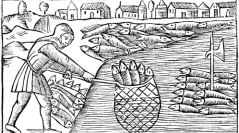

 Anthropozoologica
53 (6) - Pages 81-86
Anthropozoologica
53 (6) - Pages 81-86Wider herring fishing appeared in the Northern seas in the late Middle Ages. It became a godsend for urban markets, which needed plentiful and cheap food. Herring was a mass product in Northern Europe at that time and supplied mainly towns. That situation supposed to master new fishing and sailing techniques needed for such food supplies. Herring fishing was a novelty for it was not organised locally anymore. Fishing sites may be compared to series of hubs that assembled together different processes that followed the migration of fish. The sea itself thus became a kind of hinterland for urban markets. Then, when herrings were unloaded, public authorities took many measures (against fraud or too plentiful catches) that show the social significance of this fish. All of this led to the creation of specialised fishing staffs, which gave birth to the figure of the fisherman as a rival of the old fishing farmer. From this point of view, the Nordic seas became a new geographic centre for the European economy.
Fishing, herring, supply, maritime resources.